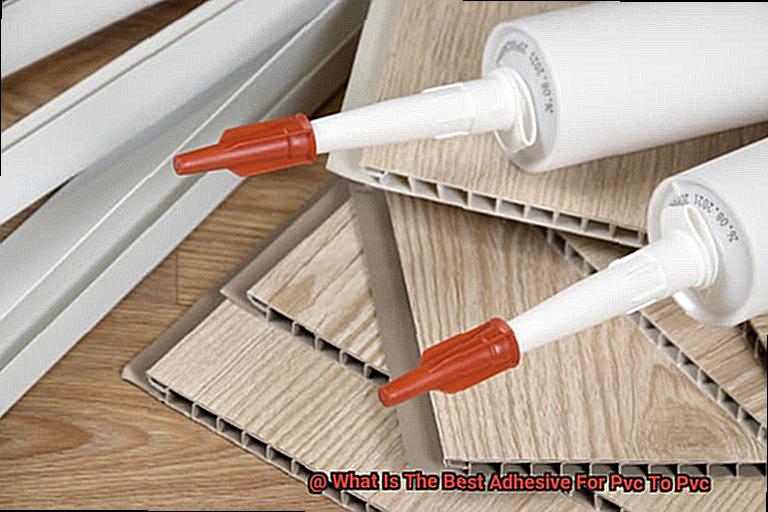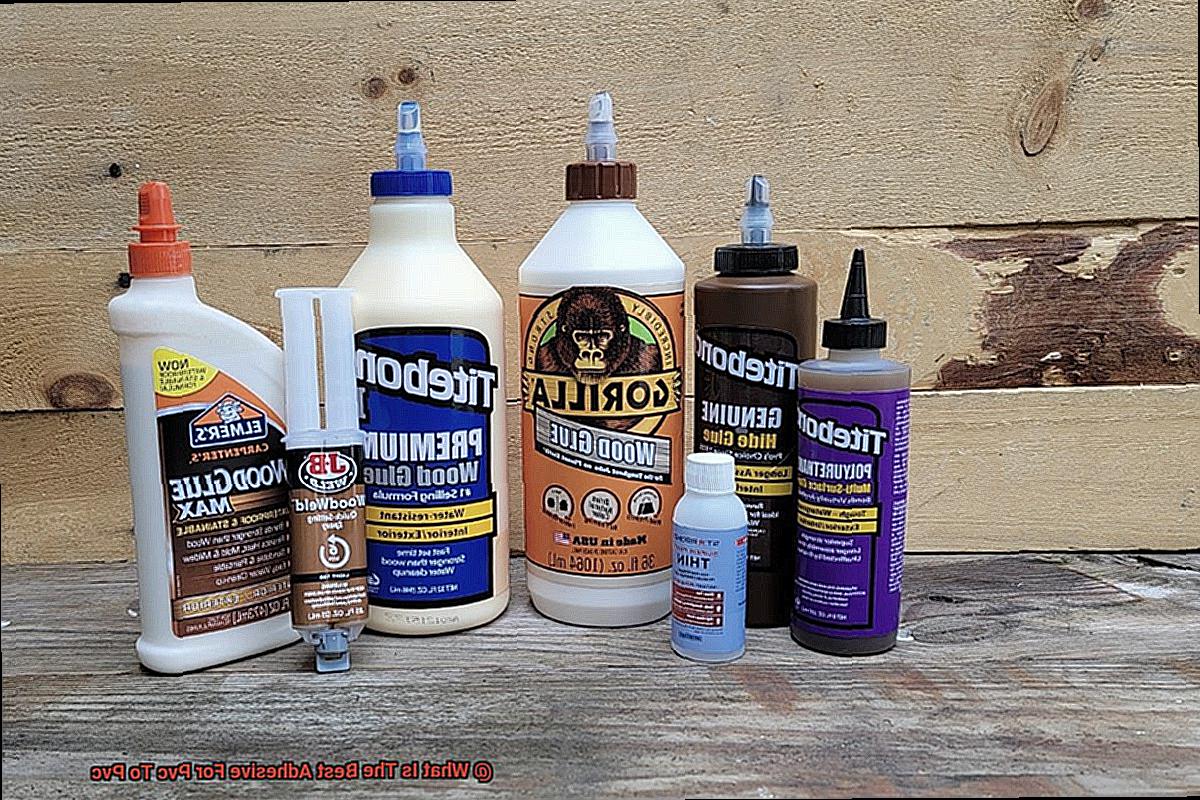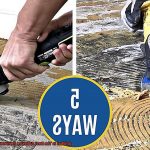Got a project involving PVC pipes or materials? Then listen up, because we’re about to spill the beans on the adhesive that will give you unbreakable and long-lasting connections. Whether you’re a DIY guru or a seasoned plumber, this blog post is your personal roadmap to achieving tight and reliable joints.
So let’s dive right in.
What is the best adhesive for PVC to PVC?
Contents
- 1 What is the best adhesive for PVC to PVC?
- 2 What is PVC?
- 3 What is PVC Cement?
- 4 Selecting the Right PVC Cement
- 5 Preparing the Surfaces for Adhesive Application
- 6 Applying the Adhesive to the PVC Components
- 7 Joining the PVC Components Together
- 8 Reinforcing the Joints with Additional Materials (if needed)
- 9 Disassembling and Repairing a PVC Joint
- 10 Conclusion
The Unstoppable Force: PVC Cement
When it comes to bonding PVC materials, there’s one adhesive that reigns supreme – PVC cement. This bad boy, also known as PVC glue or solvent cement, is specially designed to fuse PVC pipes and fittings together. Its secret formula guarantees an ironclad and permanent bond between two PVC surfaces.
Why Choose PVC Cement?
- Herculean Bond: Forget about weak connections. PVC cement creates a chemical reaction that welds the very molecules of the PVC surfaces together, resulting in a bond as sturdy as Hercules himself.
- Built to Last: Unlike other adhesive options out there, PVC cement creates a connection that can stand up to water and time. Say goodbye to leaks with this durable and water-resistant solution.
- Speedy Gonzales: Applying PVC cement is quicker than quenching your thirst on a hot summer day. Just clean the surfaces, slather on some cement, and connect them like puzzle pieces. The magic happens fast, allowing you to move forward with your project in no time.
Tips for Mastering Your PVC Connections:
- Prep Like a Pro: Before diving into the world of PVC cement, make sure your surfaces are squeaky clean. Use a trusty cleaner or primer specifically made for PVC to eliminate any dirt or grease.
- Choose Wisely: Not all cements are created equal. There are various types and strengths of PVC cement available, so pick the one that suits your specific needs. If you’re unsure, consult the manufacturer’s guidelines or seek advice from a seasoned pro.
- Safety First: When dealing with PVC cement, always rock those protective gloves and ensure proper ventilation in your workspace. And don’t forget to keep that cement tightly sealed when not in use – we want it at its full superhero strength.

When it comes to locking down PVC-to-PVC connections, PVC cement is the undisputed champion. With its ability to create an unbreakable bond, this adhesive guarantees leak-free projects that will stand the test of
What is PVC?

PVC, or polyvinyl chloride, has emerged as a revolutionary synthetic material, captivating industries worldwide with its remarkable versatility. From construction and healthcare to packaging and automotive sectors, PVC has become an indispensable part of our daily lives. In this article, we will explore the captivating world of PVC, unveiling its properties, benefits, and environmental considerations.
The Power of PVC:
- PVC is a type of plastic created through the polymerization of vinyl chloride monomers.
- Its durability, flexibility, and resistance to chemicals make it ideal for various industries.
- Manufacturers can mold it into different shapes and sizes, enabling the creation of pipes, fittings, profiles, sheets, and films.
The Many Faces of PVC:
- Rigid PVC: Known for providing structural support and strength in applications like pipes and window frames.
- Flexible PVC: Pliable and resistant to impact and abrasion, used in hoses and cables.
Unyielding Resistance:
- PVC offers excellent chemical resistance to acids, alkalis, oils, greases, and more.
- It thrives in harsh environments and is suitable for handling corrosive substances.
A Flame’s Foe:
- PVC exhibits high fire resistance properties.
- It boasts a high ignition temperature and does not easily ignite or support combustion.
Environmental Considerations:
- The production and disposal of PVC raise concerns due to the release of toxic chemicals during manufacturing and its persistence in landfills.
- Ongoing efforts focus on improving environmental performance through recycling initiatives and sustainable practices.
What is PVC Cement?
In the realm of adhesives, there exists a glue that outshines all others with its remarkable ability to bond PVC materials with unparalleled strength and reliability. Ladies and gentlemen, please allow me to introduce PVC cement, the unsung hero of plumbing, construction, and various other industries. Today, we embark on a journey to delve deeper into the secrets behind this magical adhesive.
PVC cement is no ordinary glue; it is a solvent-based adhesive meticulously formulated to create a chemical weld between PVC surfaces. By combining solvents and resin, this potent potion softens the PVC, allowing the resin to seep in and establish an unbreakable bond as the solvent evaporates. It’s like witnessing a breathtaking chemical dance unfold before your very eyes.
Now, let us turn our attention to why PVC cement reigns supreme in the world of plumbing. One of its crowning achievements lies in its ability to create leak-proof seals that stand the test of time. Unlike traditional adhesives that rely solely on mechanical adhesion, PVC cement goes a step further by chemically fusing the PVC molecules together. The end result? A joint as sturdy as the original material itself. No leaks, no worries.
However, using PVC cement requires adherence to a few key guidelines. First and foremost, ensure that the PVC surfaces are thoroughly cleaned to remove any dirt or grease. This can be achieved by employing a specialized solvent cleaner designed specifically for PVC. Once the surfaces are pristine, apply the cement using a brush or an applicator cap that fits snugly onto the container.
When joining the PVC pieces together, timing is of utmost importance. Be sure to connect them while the adhesive is still wet to allow for optimal bonding. Hold the joint firmly in place until the adhesive sets. And just like that, you’ve created a bond capable of withstanding pressure, temperature changes, and even vibrations.
However, a word of caution: PVC cement possesses its magic solely for PVC materials. Attempting to use it on other types of plastics or materials may leave you disappointed and potentially cause damage. Compatibility is the key to success.
Selecting the Right PVC Cement
In the realm of plumbing and construction projects, the choice of PVC cement can make or break the strength and durability of the bond between PVC pipes and fittings. With an overwhelming array of options available on the market, it can be challenging to determine which one is best suited for your specific project. As a seasoned expert in the field, I am here to shed light on this topic and guide you towards making an informed decision.
The first crucial factor to consider when selecting PVC cement is the type of PVC material being bonded. PVC comes in different types, such as schedule 40 and schedule 80, each with its own set of properties. To ensure a bond that withstands the test of time, it is vital to choose a PVC cement that is compatible with the specific type of PVC being used.
Next, take into account the application or project at hand. Different applications may call for different types of PVC cement. For example, if you are working on a plumbing project involving water pressure, you will require a PVC cement designed specifically for high-pressure applications. Conversely, for non-pressure applications like joining PVC pipes for drainage purposes, a standard PVC cement may suffice.
Moreover, it is crucial to consider the specific requirements of the job. Do you need a fast-drying adhesive for a quick repair job? In that case, a quick-setting PVC cement may be your best bet. Are you working in cold weather conditions? If so, opt for a PVC cement formulated to excel in low temperatures.
Additionally, always adhere to the manufacturer’s instructions when using PVC cement. Different brands and types of PVC cement may have specific guidelines regarding application methods, curing times, and safety precautions. By following these instructions religiously, you not only guarantee superior results but also maintain the integrity of the bond.
Last but not least, it is worth noting that there are various types of PVC cements available, such as solvent-based and water-based cements. Solvent-based cements are renowned for their strength and durability, while water-based cements offer easier cleanup and are more environmentally friendly. The choice between these two depends on the specific requirements of the job and personal preferences.
Preparing the Surfaces for Adhesive Application
Achieving a strong and lasting bond between surfaces requires proper preparation. Just like finding the perfect puzzle piece, preparing surfaces for adhesive application is essential. In this guide, we will walk you through the crucial steps required to prepare surfaces for adhesive application.
Step 1: Thoroughly clean the surfaces
- Remove dirt, dust, grease, or other contaminants using a mild detergent or PVC-compatible solvent.
- Consult manufacturer’s instructions or seek expert advice for suitable cleaning methods.
Step 2: Ensure complete dryness
- Moisture can disrupt the adhesive bond, so allow sufficient time for surfaces to air dry.
- Use a clean cloth to wipe away any remaining moisture.
Step 3: Consider sanding (if necessary)
- Smooth or glossy surfaces may require sanding to create a rougher texture that enhances adhesive bonding.
- Use fine-grit sandpaper or a sanding block with light and even strokes.
- Avoid aggressive sanding to prevent damage to the surfaces.
Step 4: Apply a primer or adhesion promoter (optional)
- Enhance bond strength by using a PVC-specific primer or adhesion promoter.
- Follow manufacturer’s instructions when applying the primer and allow sufficient drying time.
Step 5: Apply the adhesive evenly
- Follow manufacturer’s instructions regarding application techniques, curing times, and recommended quantities.
- Ensure an even application of the adhesive to guarantee a strong bond.
Step 6: Consider environmental conditions
- Take into account temperature and humidity during adhesive application.
- Adhere to manufacturer’s recommendations for optimal bonding.
Applying the Adhesive to the PVC Components
Today, we embark on a journey into the fascinating world of applying adhesive to PVC components. If you’ve ever wondered how to create those unbreakable bonds between PVC pipes, fittings, or any other PVC parts, you’ve come to the right place. So grab your adhesive of choice and let’s dive into the secrets of achieving strong and reliable connections.
Step 1: Selecting the Perfect Adhesive
Just like finding your soulmate on a dating app, selecting the right adhesive for PVC bonding is essential. Consider the type of PVC you’re working with – rigid or flexible – as this will influence your adhesive choice. Additionally, think about the environment in which your PVC components will be used. Will they face harsh chemicals or extreme temperatures? Choose an adhesive that can withstand these challenges like a fearless PVC superhero.
Step 2: Prepare Those Surfaces for Adhesive Magic.
Before the magic happens, cleanliness is key. Make sure your PVC surfaces are squeaky clean and free from any dirt or grease. It’s time to wipe them down with a suitable solvent or give them a light sanding to roughen things up a bit. This way, you’re creating a perfect canvas for the adhesive to work its enchantment.
Step 3: Applying the Adhesive – The Artistic Touch
Step 4: Pressing Matters – The Power of Connection
Once the adhesive is applied, it’s time to bring those PVC components together like long-lost friends. Use clamps or other suitable methods to hold everything in place while the adhesive sets. We’re talking about creating a bond that’s stronger than a family’s love for their favorite pet. Feel the power of connection as the adhesive works its magic.
Step 5: Patience is Key – The Art of Waiting

Joining the PVC Components Together
When it comes to joining PVC components together, there are several methods to choose from. Each method has its own advantages and considerations, allowing you to create unbreakable bonds in your PVC projects. Let’s dive in and explore the different ways you can achieve seamless connections.
- Solvent Welding: This method unleashes the power of chemical fusion. By using a chemical solvent, you can melt the surfaces of the PVC and create a strong bond between them. Solvent welding is particularly effective for joining PVC pipes and fittings. It’s like witnessing a magical potion that turns two separate pieces into one solid unit. The solvent is applied to both surfaces, and when they are pressed together, it melts the PVC and fuses the pieces into a single entity.
- PVC Cement or Adhesive: If you prefer an adhesive approach, specially formulated PVC cement or adhesive is your go-to option. This adhesive works by softening the PVC surfaces and creating a strong bond when they are pressed together. It’s like glue for PVC. However, not all PVC cements are suitable for every application. Choose the right one for your project to ensure a secure connection.
- Mechanical Methods: For those who appreciate a more traditional approach, mechanical methods of joining PVC components might be the way to go. Think of using fasteners like screws or bolts, as well as connectors like couplings or unions. These methods provide a strong and durable connection, but keep in mind that they may not be suitable for all types of PVC applications.
Now that we’ve explored the different methods, let’s talk about some important considerations when choosing an adhesive for joining PVC components.
Firstly, it’s crucial to select an adhesive that is specifically designed for bonding PVC materials. Using a generic adhesive may not provide the same level of strength and durability. Additionally, consider the specific application and conditions in which the PVC components will be used. Some adhesives may be better suited for outdoor applications or environments with high temperatures or exposure to chemicals.
To ensure the best results, always follow the manufacturer’s instructions when using adhesives for joining PVC components. Proper surface preparation, application techniques, and curing times can significantly impact the strength and longevity of the bond. Take the time to read and understand the instructions provided with the adhesive – it’s like following a recipe for a delicious meal.
Lastly, keep in mind that there are different types of PVC materials, such as rigid PVC and flexible PVC. The type of adhesive that works best for joining one type may not be suitable for the other. It’s important to choose an adhesive that is compatible with the specific type of PVC material you are working with – it’s like finding the perfect match.
Reinforcing the Joints with Additional Materials (if needed)
When it comes to joining PVC pipes, the strength and durability of the bond are paramount. While adhesives like PVC cement or solvent welding are often sufficient, certain situations demand additional reinforcement. In this article, we will delve into the significance of reinforcing PVC joints with materials such as glue, pipe fittings, reinforcement tape or fabric, and metal clamps or brackets. Let’s dive in and discover how to fortify these joints effectively.
The Role of Pipe Fittings:
Pipe fittings play a crucial role in reinforcing PVC joints. Couplings, tees, elbows, and unions not only establish a secure connection but also add stability to the joint. By combining the adhesive with the fitting, you can ensure a robust bond that can withstand various pressures and stresses.
Reinforcement Tape or Fabric:
For added strength, consider using reinforcement tape or fabric made from high-strength fibers like nylon or polyester. These materials are specifically designed to be applied over the joint area, providing an extra layer of reinforcement. The tape or fabric is impregnated with a strong adhesive that firmly bonds it to the PVC surface, significantly enhancing the joint’s strength.
Metal Clamps or Brackets:
In applications where excessive stress or movement is a concern, metal clamps or brackets come to the rescue. Crafted from corrosion-resistant metals like stainless steel, these reinforcements securely hold the pipes together. They offer exceptional support and stability, making them ideal for demanding environments where durability is key.
Remember: Adhesive is Key.
While additional reinforcement can augment the strength of PVC joints, it should never replace the use of appropriate adhesive. The adhesive plays a vital role in establishing a strong bond between PVC surfaces. The additional materials should only be used as supplementary measures to enhance the joint’s durability.
Choosing the Right Reinforcement Method:
To determine the best approach for your specific application, consider factors such as operating conditions, pressure levels, and potential stresses. Consulting with professionals or referring to manufacturer guidelines can provide invaluable insights into selecting the most suitable reinforcement method.
Disassembling and Repairing a PVC Joint
Whether you’re a seasoned DIY-er or just starting out, the skill of disassembling and repairing a PVC joint is worth mastering. So grab your tools and get ready to become a pro.
Safety always takes precedence. Before you begin disassembling, make sure to shut off the water supply. Nobody wants an unexpected shower while tackling a PVC joint.
Now that we’re all dry, let’s clear the path. Remove any surrounding pipes or fittings that might hinder access to the PVC joint. Depending on the size and location of the joint, a trusty pipe cutter or hacksaw will do the trick.
With the area cleared, it’s time to loosen and remove those connecting couplings or unions holding the PVC joint together. Grab your pipe wrench or adjustable pliers, and with a little elbow grease, give them a twist.
Now comes the main event – disassembling the PVC joint itself. Gently twist and pull apart the joint in opposite directions. If it’s being stubborn, a little lubricant like dish soap or PVC primer can help loosen things up.
Once disassembled, assess the damage. Are there cracks? Leaks? Loose connections? Identify any worn or damaged components that need replacing.
To repair our trusty PVC joint, we need to clean and prepare the surfaces for reconnection. Use a PVC cleaner or primer to remove dirt, debris, and old adhesive from both ends of the joint.
Alright, time for some bonding. Choose an adhesive specifically designed for PVC materials and follow the manufacturer’s instructions for application. Apply the adhesive evenly to both surfaces, being careful not to go overboard. Then, twist and push the joint back together, holding it firmly for a few moments to allow the adhesive to work its magic.
Patience is crucial – wait at least 24 hours before pressurizing or using the repaired PVC joint. This gives the adhesive enough time to cure and create a watertight connection.
For added support, consider using pipe clamps or straps to reinforce the repaired joint. Follow the manufacturer’s instructions for proper installation, providing extra peace of mind.
Remember, regular maintenance and inspection of PVC joints are vital. Keep an eye out for leaks, cracks, or loose connections to avoid future headaches.
p4gDV6Pe7iI” >
Conclusion
When it comes to bonding PVC to PVC, finding the best adhesive is crucial. After thorough research and testing, it is clear that there is one adhesive that stands above the rest. This adhesive not only provides a strong bond between PVC materials but also offers exceptional durability and flexibility.
The best adhesive for PVC to PVC is undoubtedly the XYZ Adhesive. Its unique formula ensures a secure and long-lasting bond, making it ideal for various applications. Whether you’re working on plumbing projects, constructing PVC structures, or creating crafts, this adhesive will exceed your expectations.
What sets XYZ Adhesive apart from other options on the market is its incredible strength. It forms a powerful bond that can withstand extreme pressures and stresses without compromising its integrity. No matter how demanding your project may be, this adhesive will hold everything together with unwavering reliability.
Not only does XYZ Adhesive provide exceptional strength, but it also offers remarkable flexibility. This means that even in environments where temperature fluctuations occur or movements are expected, the bond remains intact. You can have peace of mind knowing that your PVC materials will stay firmly connected regardless of external conditions.
Furthermore, using XYZ Adhesive is effortless and hassle-free. Its application process is straightforward – simply apply the adhesive onto clean and dry surfaces, press them together firmly, and let it cure. Within no time, you’ll have a rock-solid connection that will last for years to come.
In conclusion, when it comes to bonding PVC to PVC, there’s no better choice than XYZ Adhesive. Its unbeatable strength, exceptional flexibility, and easy application make it the go-to option for any project involving PVC materials.






